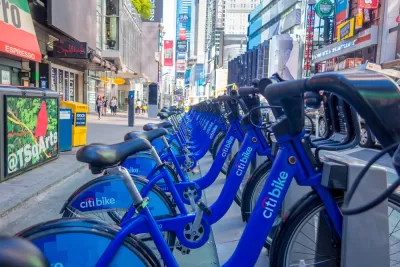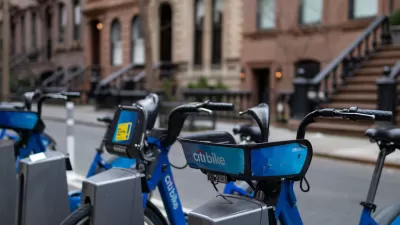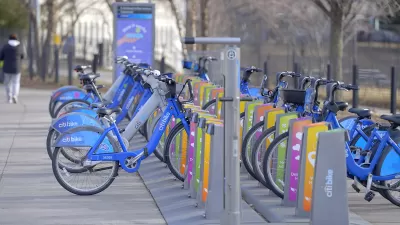The popular NYC bike share system will likely survive the company’s current financial setbacks, but other, smaller bike share systems may not be so lucky.

What does trouble at the company operating four of the top five bike share systems in the United States mean for shared bike systems and, more specifically, for New York City’s Citi Bike? Alissa Walker asks this question in Curbed, assessing how Lyft’s recent financial woes could impact U.S. bike share systems operated by the ride-hailing giant.
Walker describes the company’s history with bike share, starting with its acquisition of Motivate in 2018. “Lyft originally positioned its foray into bike share as part of building the ultimate multimodal-transportation app, bundling its ride-hailing services with bike or e-scooter rental or the ability to buy transit tickets.”
Now, with its financial future in peril, Lyft has killed some of its bike share systems altogether and increased prices in others. According to Walker, cities are once again looking at forming their own municipally owned bike share systems—a more common feature pre-Bird and Lyft—to limit the volatility and maintain service.
Walker predicts that “Even if Lyft starts making bike-share cuts in the name of cost savings, it’s unlikely New York City will see the same fate as Minneapolis,” where Lyft abruptly ended service last month. “Citi Bike — which has seen a 33 percent year-over-year increase in ridership so far in 2023 — also has the model that’s preferred by Lyft: an exclusive, multiyear, public-private partnership that Lyft says justifies infrastructural improvements and service expansions.” But the future may not be as bright for smaller cities who can’t afford the same level of commitment and funding.
FULL STORY: What Does the Potential Demise of Lyft Mean for Citi Bike?

Montreal Mall to Become 6,000 Housing Units
Place Versailles will be transformed into a mixed-use complex over the next 25 years.

Planetizen Federal Action Tracker
A weekly monitor of how Trump’s orders and actions are impacting planners and planning in America.

DARTSpace Platform Streamlines Dallas TOD Application Process
The Dallas transit agency hopes a shorter permitting timeline will boost transit-oriented development around rail stations.

Interactive Map Reveals America's “Shade Deserts”
Launched by UCLA and American Forests to combat heat-related deaths, the tool maps the shade infrastructure for over 360 U.S. cities.

Bicycles and Books — In Sacramento, Libraries Now Offer Both
Adult library card holders can check out e-bikes and e-trikes for up to one week.

Colorado Landfills Emit as Much Pollution as 1M Cars
Landfills are the third-largest source of methane pollution in Colorado, after agriculture and fossil fuel extraction.
Urban Design for Planners 1: Software Tools
This six-course series explores essential urban design concepts using open source software and equips planners with the tools they need to participate fully in the urban design process.
Planning for Universal Design
Learn the tools for implementing Universal Design in planning regulations.
City of Mt Shasta
City of Camden Redevelopment Agency
City of Astoria
Transportation Research & Education Center (TREC) at Portland State University
US High Speed Rail Association
City of Camden Redevelopment Agency
Municipality of Princeton (NJ)





























